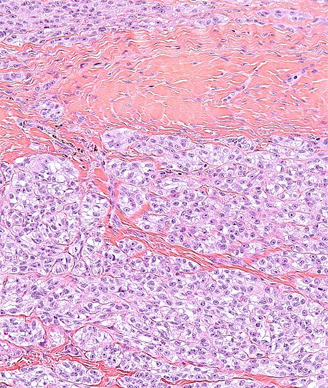Pazopanib Responders Identified in Advanced Soft-Tissue Sarcomas
Researchers have identified several characteristics of long-term responders to pazopanib in patients with advanced soft-tissue sarcomas, including having a normal hemoglobin level at baseline.
High magnification micrograph of a clear cell sarcoma in a tendon. Copyright 2012 Neprhon.

Researchers have identified several characteristics of long-term responders to pazopanib in patients with advanced soft-tissue sarcomas, including having a normal hemoglobin level at baseline.
Pazopanib was recently approved for the treatment of soft-tissue sarcomas based on the results of the EORTC Soft Tissue and Bone Sarcoma Group phase II and phase III trials that showed a significant advantage of pazopanib on progression-free survival compared with placebo. In the studies, 36% of patients had a progression-free survival of longer than 6 months, and 34% survived longer than 18 months. These patients were classified as long-term responders and long-term survivors.
Bernd Kasper, MD, PhD, of the University of Heidelberg, Germany, and colleagues conducted a pooled analysis of these long-term responders and survivors to identify characteristics associated with these improved outcomes. The results of the study were published in Annals of Oncology.
Patient characteristics were compared among four subgroups based on survival outcomes: neither long-term response nor long-term survival; long-term survival but no long-term response; long-term response but no long-term survival; and both long-term response and long-term survival.
“Interestingly, characteristics associated with long-term outcome for pazopanib-treated patients are similar to those associated with long-term outcome to other agents applied in soft-tissue sarcoma such as performance status and grade of the primary tumor,” the researchers wrote.
Age had an effect on outcomes with patients in the group with long-term response and survival having the youngest median age (51 years) compared with the other groups; 41% of patients were aged younger than 40 years.
Outcomes were also different according to sex. The researchers found that there were more women than men in the two patients groups with long-term survival. In contrast, the two groups with overall survival less than 18 months had an equal distribution of men and women.
Additionally, more patients with a performance status of zero were in the two groups with long-term overall survival compared with the groups with a survival of less than 18 months. More than half of the patients identified as long-term responders or long-term survivors had a low or intermediate tumor grade at baseline.
Interestingly, the researchers found on multivariate analysis that low baseline hemoglobin was associated with a decreased likelihood of surviving longer than 18 months.
“Twelve patients (3.5%) demonstrated a clinical benefit even beyond 2 years with a median time on pazopanib treatment of 2.4 years and the longest duration of 3.7 years,” the researchers wrote. “As expected, these patients were mainly young, female, with a good performance status and had more low or intermediate grade tumors at the time of initial diagnosis and all of them had pulmonary metastases.”
Sarcoma Awareness Month 2023 with Brian Van Tine, MD, PhD
August 1st 2023Brian Van Tine, MD, PhD, speaks about several agents and combination regimens that are currently under investigation in the sarcoma space, and potential next steps in research including immunotherapies and vaccine-based treatments.